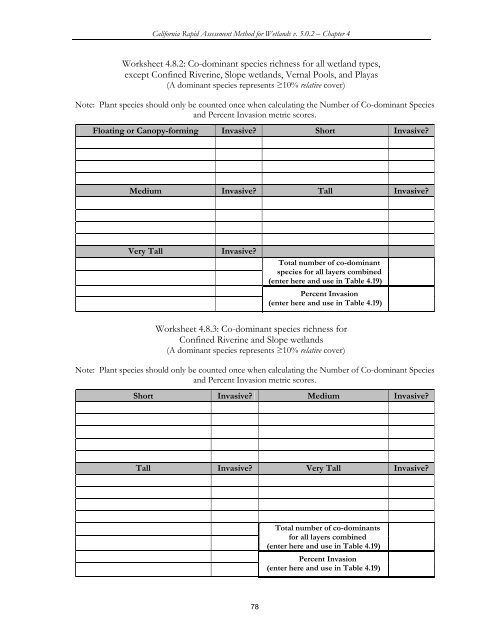(CRAM) For Wetlands User's Manual Version 5.0.2
(CRAM) For Wetlands User's Manual Version 5.0.2
(CRAM) For Wetlands User's Manual Version 5.0.2
You also want an ePaper? Increase the reach of your titles
YUMPU automatically turns print PDFs into web optimized ePapers that Google loves.
California Rapid Assessment Method for <strong>Wetlands</strong> v. <strong>5.0.2</strong> – Chapter 4<br />
Worksheet 4.8.2: Co-dominant species richness for all wetland types,<br />
except Confined Riverine, Slope wetlands, Vernal Pools, and Playas<br />
(A dominant species represents ≥10% relative cover)<br />
Note: Plant species should only be counted once when calculating the Number of Co-dominant Species<br />
and Percent Invasion metric scores.<br />
Floating or Canopy-forming Invasive? Short Invasive?<br />
Medium Invasive? Tall Invasive?<br />
Very Tall Invasive?<br />
78<br />
Total number of co-dominant<br />
species for all layers combined<br />
(enter here and use in Table 4.19)<br />
Percent Invasion<br />
(enter here and use in Table 4.19)<br />
Worksheet 4.8.3: Co-dominant species richness for<br />
Confined Riverine and Slope wetlands<br />
(A dominant species represents ≥10% relative cover)<br />
Note: Plant species should only be counted once when calculating the Number of Co-dominant Species<br />
and Percent Invasion metric scores.<br />
Short Invasive? Medium Invasive?<br />
Tall Invasive? Very Tall Invasive?<br />
Total number of co-dominants<br />
for all layers combined<br />
(enter here and use in Table 4.19)<br />
Percent Invasion<br />
(enter here and use in Table 4.19)















